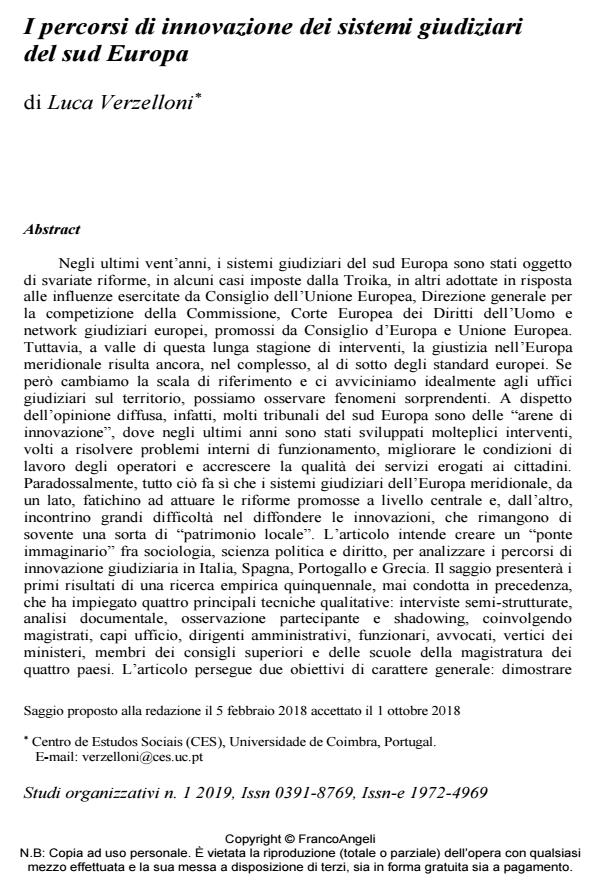I percorsi di innovazione dei sistemi giudiziari del sud Europa
Titolo Rivista STUDI ORGANIZZATIVI
Autori/Curatori Luca Verzelloni
Anno di pubblicazione 2019 Fascicolo 2019/1
Lingua Italiano Numero pagine 26 P. 97-122 Dimensione file 330 KB
DOI 10.3280/SO2019-001004
Il DOI è il codice a barre della proprietà intellettuale: per saperne di più
clicca qui
Qui sotto puoi vedere in anteprima la prima pagina di questo articolo.
Se questo articolo ti interessa, lo puoi acquistare (e scaricare in formato pdf) seguendo le facili indicazioni per acquistare il download credit. Acquista Download Credits per scaricare questo Articolo in formato PDF

FrancoAngeli è membro della Publishers International Linking Association, Inc (PILA)associazione indipendente e non profit per facilitare (attraverso i servizi tecnologici implementati da CrossRef.org) l’accesso degli studiosi ai contenuti digitali nelle pubblicazioni professionali e scientifiche
Negli ultimi vent’anni, i sistemi giudiziari del sud Europa sono stati oggetto di svariate riforme, in alcuni casi imposte dalla Troika, in altri adottate in risposta alle influenze esercitate da Consiglio dell’Unione Europea, Direzione generale per la competizione della Commissione, Corte Europea dei Diritti dell’Uomo e network giudiziari europei, promossi da Consiglio d’Europa e Unione Europea. Tuttavia, a valle di questa lunga stagione di interventi, la giustizia nell’Europa meridionale risulta ancora, nel complesso, al di sotto degli standard europei. Se però cambiamo la scala di riferimento e ci avviciniamo idealmente agli uffici giudiziari sul territorio, possiamo osservare fenomeni sorprendenti. A dispetto dell’opinione diffusa, infatti, molti tribunali del sud Europa sono delle "arene di innovazione", dove negli ultimi anni sono stati sviluppati molteplici interventi, volti a risolvere problemi interni di funzionamento, migliorare le condizioni di lavoro degli operatori e accrescere la qualità dei servizi erogati ai cittadini. Paradossalmente, tutto ciò fa sì che i sistemi giudiziari dell’Europa meridionale, da un lato, fatichino ad attuare le riforme promosse a livello centrale e, dall’altro, incontrino grandi difficoltà nel diffondere le innovazioni, che rimangono di sovente una sorta di "patrimonio locale". L’articolo intende creare un "ponte immaginario" fra sociologia, scienza politica e diritto, per analizzare i percorsi di innovazione giudiziaria in Italia, Spagna, Portogallo e Grecia. Il saggio presenterà i primi risultati di una ricerca empirica quinquennale, mai condotta in precedenza, che ha impiegato quattro principali tecniche qualitative: interviste semi-strutturate, analisi documentale, osservazione partecipante e shadowing, coinvolgendo magistrati, capi ufficio, dirigenti amministrativi, funzionari, avvocati, vertici dei ministeri, membri dei consigli superiori e delle scuole della magistratura dei quattro paesi. L’articolo persegue due obiettivi di carattere generale: dimostrare che, anche in contesti fortemente regolamentati e apparentemente rigidi - come, appunto, i tribunali - vi siano degli spazi, più o meno ampi, per l’innovazione e fornire ai policy makers delle indicazioni per la governance di questi particolari sistemi organizzativi, che tengano conto delle loro caratteristiche distintive. Il saggio ambisce a promuovere la nascita di un dibattito allargato sugli effetti perversi e paradossali del continuo ricorso all’innovazione, non soltanto in ambito giudiziario, ma in tutti i settori della pubblica amministrazione.
Parole chiave:Innovazione, giustizia, Europa del sud, margine di manovra, paradosso, sistemi a legame debole
Luca Verzelloni, I percorsi di innovazione dei sistemi giudiziari del sud Europa in "STUDI ORGANIZZATIVI " 1/2019, pp 97-122, DOI: 10.3280/SO2019-001004